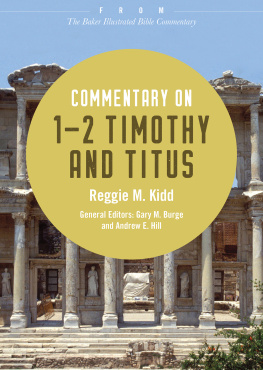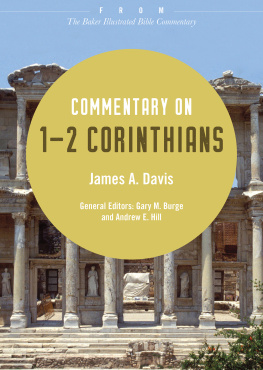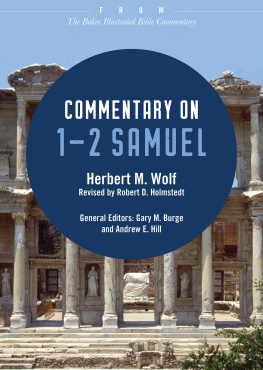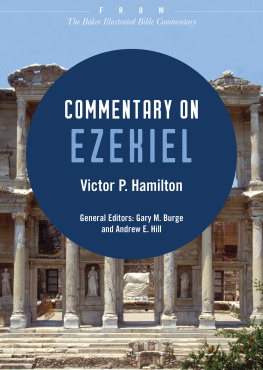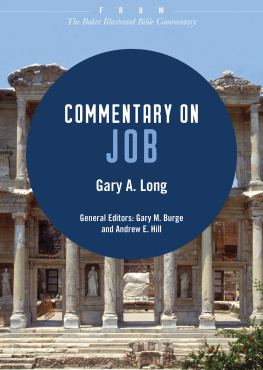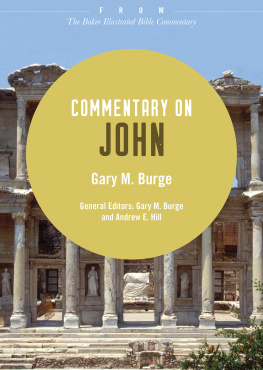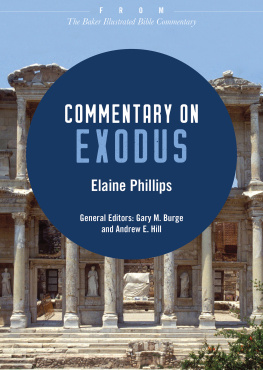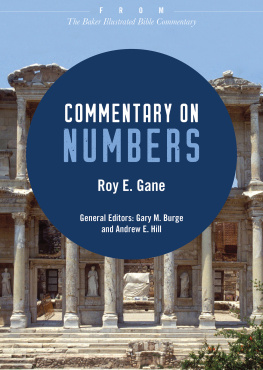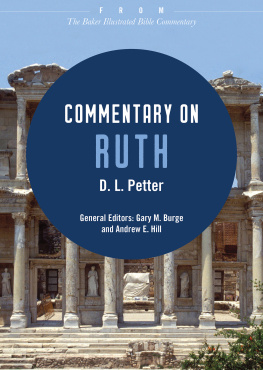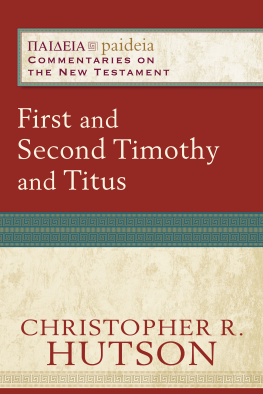Copyright Page
2012 by Baker Publishing Group
Published by Baker Books
a division of Baker Publishing Group
P.O. Box 6287, Grand Rapids, MI 49516-6287
www.bakerbooks.com
Ebook short created 2019
Previously published in The Baker Illustrated Bible Commentary edited by Gary M. Burge and Andrew E. Hill in 2012
All rights reserved. No part of this publication may be reproduced, stored in a retrieval system, or transmitted in any form or by any meansfor example, electronic, photocopy, recordingwithout the prior written permission of the publisher. The only exception is brief quotations in printed reviews.
Library of Congress Cataloging-in-Publication Data is on file at the Library of Congress, Washington, DC.
ISBN 978-1-4934-2475-7
Unless otherwise indicated, Scripture quotations are from the Holy Bible, New International Version. NIV. Copyright 1973, 1978, 1984, 2011 by Biblica, Inc. Used by permission of Zondervan. All rights reserved worldwide. www.zondervan.com. The NIV and New International Version are trademarks registered in the United States Patent and Trademark Office by Biblica, Inc.
Scripture quotations labeled ESV from The Holy Bible, English Standard Version (ESV), copyright 2001 by Crossway, a publishing ministry of Good News Publishers. Used by permission. All rights reserved. ESV Text Edition: 2007
Scripture quotations labeled NASB are from the New American Standard Bible, copyright 1960, 1962, 1963, 1968, 1971, 1972, 1973, 1975, 1977, 1995 by The Lockman Foundation. Used by permission. www.lockman.org
Scripture quotations labeled NIV 1984 are from the HOLY BIBLE, NEW INTERNATIONAL VERSION. NIV. Copyright 1973, 1978, 1984 by International Bible Society. Used by permission of Zondervan. All rights reserved.
Scripture quotations labeled NJPS are from the New Jewish Publication Society Version 1985 by The Jewish Publication Society. All rights reserved.
Scripture quotations labeled NKJV are from the New King James Version. Copyright 1982 by Thomas Nelson, Inc. Used by permission. All rights reserved.
Scripture quotations labeled NLT are from the Holy Bible , New Living Translation, copyright 1996, 2004, 2007 by Tyndale House. Used by permission of Tyndale House Publishers, Inc., Carol Stream, Illinois 60188. All rights reserved.
Scripture quotations labeled NRSV are from the New Revised Standard Version of the Bible, copyright 1989, by the Division of Christian Education of the National Council of the Churches of Christ in the United States of America. Used by permission. All rights reserved.
Scripture quotations labeled RSV are from the Revised Standard Version of the Bible, copyright 1952 [2nd edition, 1971] by the Division of Christian Education of the National Council of the Churches of Christ in the United States of America. Used by permission. All rights reserved.
Unless otherwise indicated, photos, illustrations, and maps are copyright Baker Photo Archive.
Contents
Abbreviations
| ANET | Ancient Near Eastern Texts Relating to the Old Testament . Edited by J. B. Pritchard. 3rd ed. Princeton, 1969 |
| BDAG | Bauer, W., F. W. Danker, W. F. Arndt, and F. W. Gingrich. Greek-English Lexicon of the New Testament and Other Early Christian Literature. 3rd ed. Chicago, 1999 |
| ca. | circa (about, approximately) |
| cf. | compare |
| chap(s). | chapter(s) |
| COS | The Context of Scripture . Edited by W. W. Hallo. 3 vols. Leiden, 1997 |
| e.g. | for example |
| ESV | English Standard Version |
| HALOT | Koehler, L., W. Baumgartner, and J. J. Stamm. The Hebrew and Aramaic Lexicon of the Old Testament. Translated and edited under the supervision of M. E. J. Richardson. 5 vols. Leiden, 19942000 |
| HCSB | Holman Christian Standard Bible |
| i.e. | that is |
| KJV | King James Version |
| NASB | New American Standard Bible |
| NEB | New English Bible |
| NET | New English Translation |
| NIV | New International Version (2011 edition) |
| NIV 1984 | New International Version (1984 edition) |
| NJB | New Jerusalem Bible |
| NJPS | The Tanakh: The Holy Scriptures: The New JPS Translation according to the Traditional Hebrew Text |
| NKJV | New King James Version |
| NLT | New Living Translation |
| NRSV | New Revised Standard Version |
| RSV | Revised Standard Version |
| TDOT | Theological Dictionary of the Old Testament . Edited by G. J. Botterweck and H. Ringgren. Translated by J. T. Willis, G. W. Bromiley, and D. E. Green. 8 vols. Grand Rapids, 1974 |
| TNIV | Todays New International Version |
12 Timothy and Titus
Reggie M. Kidd
Introduction
The letters to Timothy and Titus, called the Pastoral Epistles, raise questions about the legacy of the apostle Paul. Evangelical scholars and some mainstream conservative scholars believe these writings provide Pauls own ideas and applications for the next generation of church leaders. Other mainstream scholars tend to think the Pastorals came from the second or third generation of the Pauline movement and represent a falling away from Pauls original vision.
This commentary treats the Pastoral Epistles as Pauls own explanation of his main theological values, which he designs to reflect the culture of his heirs in ministry.

Distinctive Features
The Pastorals share a range of common features with the earlier letters of Paul but stand apart in several respects.
First, they are letters written to Pauls co-workers as individuals instead of to a church or house church. (Philemon, by contrast, was written to a house churchsee Philem. 2). Further, the Pastorals were written to perhaps the most Greek of Pauls protgs: though half Jewish, Timothy had not even been circumcised at infancy; and the Gentile Titus was pointedly never circumcised (Gal. 2:3).
Second, the Pastorals show a distinctive writing style, marked by a smoother flow of sentences and less complicated grammar.
Third, the vocabulary shows more Greek influence. A third of the Pastorals vocabulary does not appear in the earlier writings of Paul. Words otherwise not used in the New Testament occur at the rate of about four to five per page in the earlier letters, but at the rate of about thirteen per page in the Pastorals. Some of this vocabulary is common to Greek moral and theological writings. Worthy of mention are the following: godliness/piety, appearance (instead of Pauls more characteristic presence), and healthy/sound. Jewish writers like Philo of Alexandria, aiming at a Greek readership, had already begun using many of the terms that distinguish the Pastorals from Pauls earlier letters.
It is interesting to note that Luke (Pauls traveling companion, lone associate during the writing of 2 Timothy, and author of Luke-Acts) shares much of this vocabulary, lending support to the possibility that Luke assisted Paul with these letters. Two examples: first, Pauls earlier letters denounce greed (1 Cor. 6:10; 1 Thess. 2:5), but the Pastorals and Luke denounce love of money (1 Tim. 6:10; 2 Tim. 3:2; cf. Luke 12:15; 16:14). Second, of the other New Testament writers, only Luke (the beloved physician) uses the Greek term from which we get hygienic to refer to the spiritual aspect of Jesuss healing ministry (Luke 5:17; 15:27). The Pastorals use the same term to stress that doctrine should be not merely correct but also healthy or sound (1 Tim. 1:10; 2 Tim. 4:3; Titus 1:9; 2:1).

